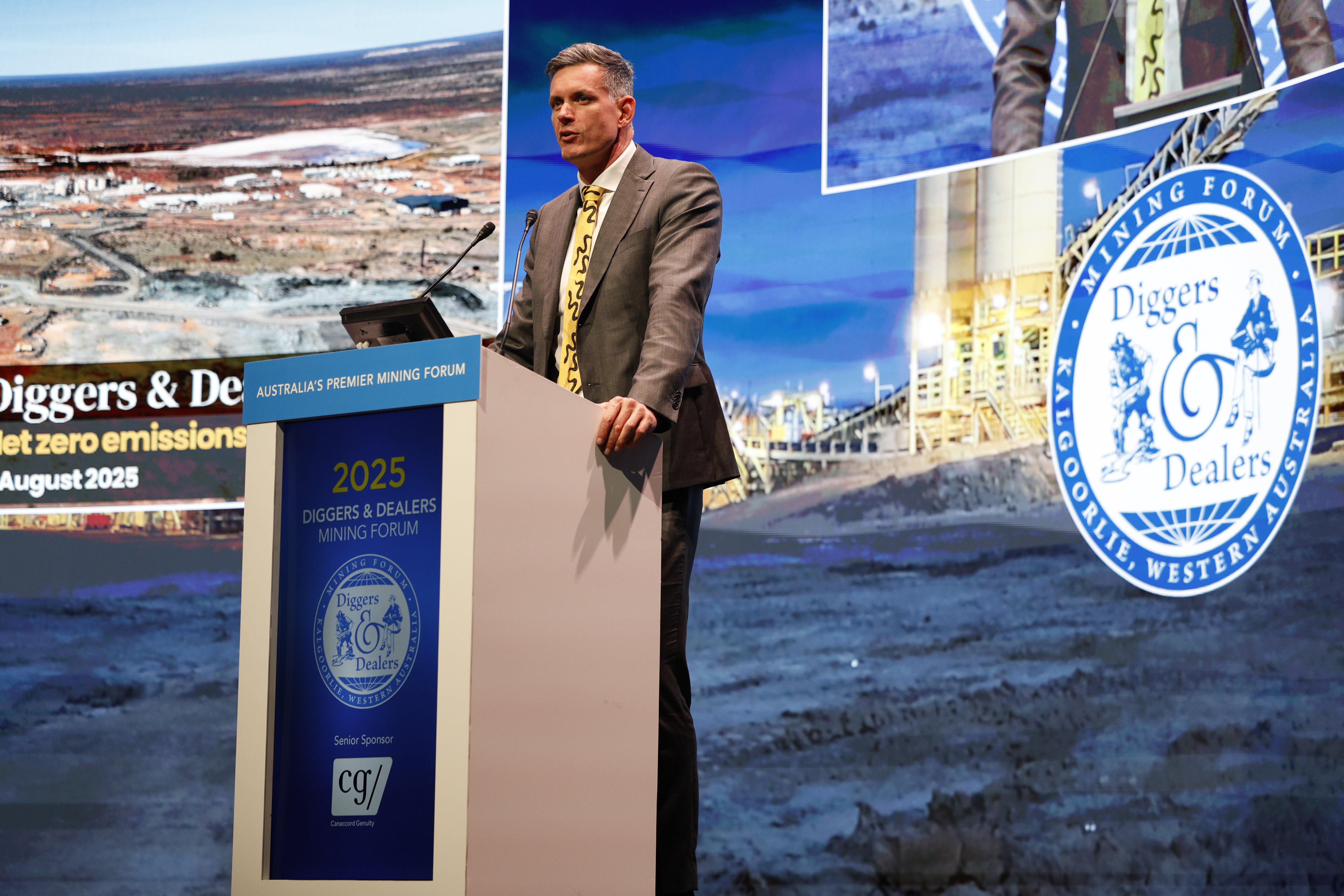Diggers and Dealers: Gold is green? Bellevue says it’s the world’s first Net Zero gold miner

Bellevue Gold has claimed Net Zero status. Pic: Getty Images
- Bellevue Gold claims it’s now producing and selling “green gold” after WA mine hit Net Zero for H1 2025
- Access to green premium in focus as miner hopes long term benefits will justify initial costs
- Bellevue’s potential as a takeover target has been common water cooler chat at Diggers and Dealers
Bellevue Gold (ASX:BGL) claims it’s beat global mining majors to a big ESG prize, turning its mine of the same name in WA into the first ‘Net Zero’ gold mine in the world.
The miner says its high renewable penetration, blended with the purchase of carbon credits, has seen it claim Net Zero status for the first half of calendar 2025, setting it on a path to meet its 2026 schedule.
While gold’s rapid rise in 2025 has been powered by safe haven demand from investors in turbulent economic times and central bank buying, Bellevue is now targeting the high end jewellery market which makes up around 40% of demand.
It’s testing the waters with east coast gold refiner ABC Refinery and Single Mine Origin to sell gold to ‘ethical buyers’, potentially opening the door to a ‘green premium’.
The move echoes provenance assessments in supply chains for natural mined diamonds.
Bellevue has installed a 90MW hybrid power station at its mine of the same name, including 24MW of wind turbines, 27MW solar and a 24MW thermal plant with 15MW/29MWh of battery storage, claiming to have run for 58 hours on 100% renewable energy in the month of June after its wind turbines were commissioned.
The company has forecast annualised renewable energy penetration of between 80-90% depending in its solar and wind resources and the mine’s power demand.
BGL claims it’s had Net Zero emissions for the first half of CY25, including Scope 1 and Scope 2 emissions under the company’s control.
That doesn’t take into account Scope 3 emissions generated in further processing, refining and transport of the gold or its future use in the manufacture of products.
It’s yet to be disclosed how much Bellevue spent on carbon credits, with MD Darren Stralow telling media on the sidelines of the Diggers and Dealers Mining Forum the aim was for the green premium to eventually cover the costs.
While its power costs are marginally higher at the moment than they may have been under a solely thermal power supply, Stralow says the decision to conduct the massive solar, wind and battery rollout would pay itself back in the long term.
“We are probably paying a few cents per kilowatt hour more than we would if we’d just gone straight down the thermal version,” he said.
“But the benefits that it gives the company in terms of the ability to get the premium, the protection against future carbon taxes and future hydrocarbon increases should the price of gas or diesel go up in the future, we see as a long term benefit.
“So, yeah, a little bit more expensive, but hopefully it’s something that evens out over time.”
Some performance rights for directors and staff were tied to the delivery of the Net Zero target in the form of sustainability performance rights, claimed as a first by the company as recently as its 2024 sustainability report.

Hard to abate
Even with the massive renewable energy draw, carbon credits will continue to be a feature of the Net Zero picture for the foreseeable future.
Trials to go fully electric with an underground jumbo have delivered mixed results. The solution is likely to be a diesel-electric hybrid OEMs are looking to roll out, Stralow said.
“So we didn’t do electric trucks and loaders, we did an electric jumbo with sort of varied success,” he noted.
“We were a part of a group called the EMC … the Electric Mine Consortium, which ran for a few years and ran a project across a whole bunch of different mine sites on electrification and how it works.
“Where the technology looks to be going in the near to medium term is that rather than go to full electrification from now, it’s going to go from how they’re running now to, to diesel-electric, which use about 40% less, emissions.
“And so the next generation of the fleet that comes out will be diesel-electric and we’ll be an embracer of that technology because it’s very reliable.”
Bellevue’s announcement comes at a time of wavering interest in ESG, with energy security, cost of living and political shift to the right in the US and Europe clouding the fervour behind the theme in investment circles.
Diggers and Dealers began with a keynote speak from a Canadian nuclear advocate and libertarian think tank the Centre for Independent Studies criticising the Albanese Government’s approach to and dream to hit Net Zero by 2050.
Stralow said the needs of a remote mine were different to those of a whole power grid, where energy cost and reliability, particularly for industrial factories like smelters, has become a major concern across Australia’s manufacturing sector.
As for the “green-gold”, Stralow is hopeful the mine, one of four to supply SMO’s customers alongside three in Africa, will find willing buyers in the European jewellery market and among ESG conscious central banks.
“(Carbon credit purchasing) is going to reduce over the next six months as well as the full benefit of the wind power, because that that wind turbine and wind power stuff was only commissioned in May-June last year,” he added.
“It’s going to cost us less and less going forward and hopefully certainly covered by the premium is what we’re we’re expecting.”
Focus on future
The news comes with Bellevue among the closest watched stocks at this year’s Diggers and Dealers forum.
Despite a record run for gold prices to US$3375/oz – including a ~30% lift in bullion prices over the first half of 2025 – the company is down 25% YTD.
Speculation a cashed up competitor will move to buy the mine and/or company is rife, with loose-lipped executives around the Kalgoorlie conference openly commenting on the idea the mine is in play.
Having initially set guidance of 165,000-180,000oz in FY25, that number was knocked down in January and then further clipped in April to 129,000-134,000oz at all in sustaining costs of $2425-2525/oz.
But beyond that, analysts were forced to chop longer term cashflow expectations after BGL cut its post FY29 guidance from 250,000ozpa to 190,000ozpa.
BGL eventually delivered 130,164oz for FY25 at AISC of $2422/oz.
It’s set guidance for FY26 of 130-150,000ozpa at $2600-2900/oz, ramping up to 175,000-195,000ozpa in FY27.
Stralow denied the takeover defence and strategic review process, which includes an open dataroom, would distract the miner.
He believes the negative surprises of the past year are behind it, after the $1.25bn producer reset investor expectations and delayed hedge arrangements with its banker Macquarie, enabling full access to +$5000/oz gold prices.
“I think the feedback we’re certainly getting is that, Bellevue hasn’t really had a lot of conservative guidance in the market,” Stralow said.
“We’ve really focused on what we’re saying to the market now being conservative, deliverable and within the means of exactly what we’re doing at the moment.
“We’ve got a really strong relationship with Macquarie, they’ve signed off on the plan.
“The plan delivers the guidance. It’s really just about resetting things and starting from a base that we know we can achieve.”

UNLOCK INSIGHTS
Discover the untold stories of emerging ASX stocks.
Daily news and expert analysis, it's free to subscribe.
By proceeding, you confirm you understand that we handle personal information in accordance with our Privacy Policy.








